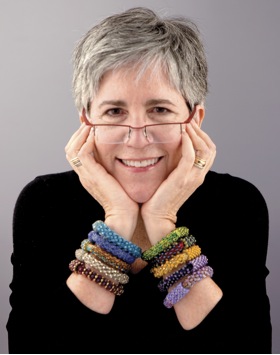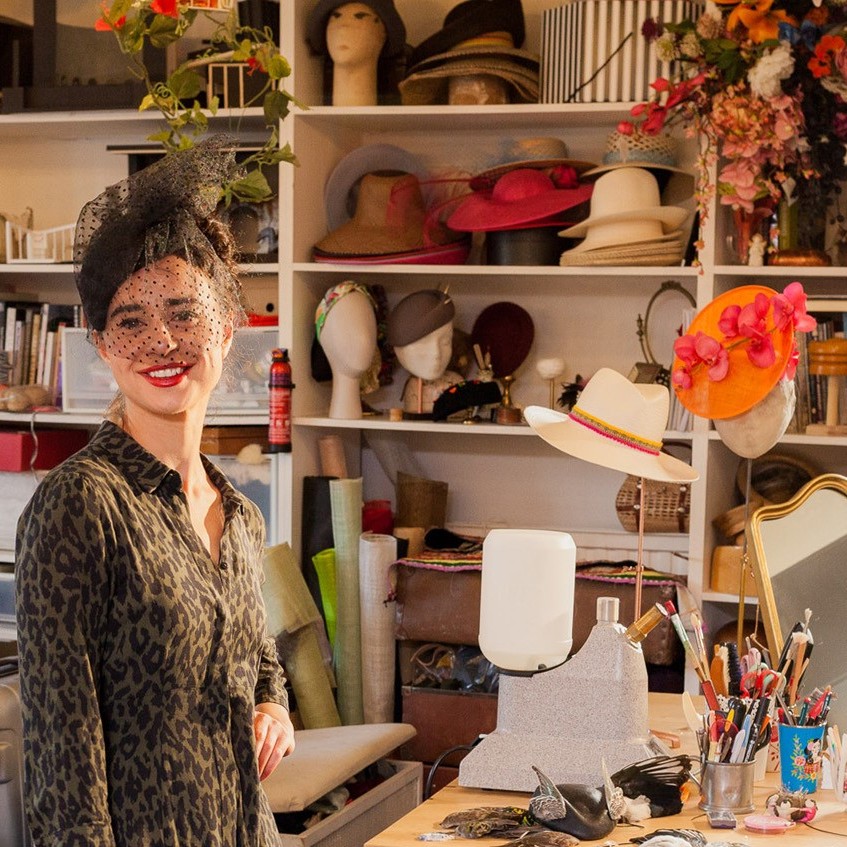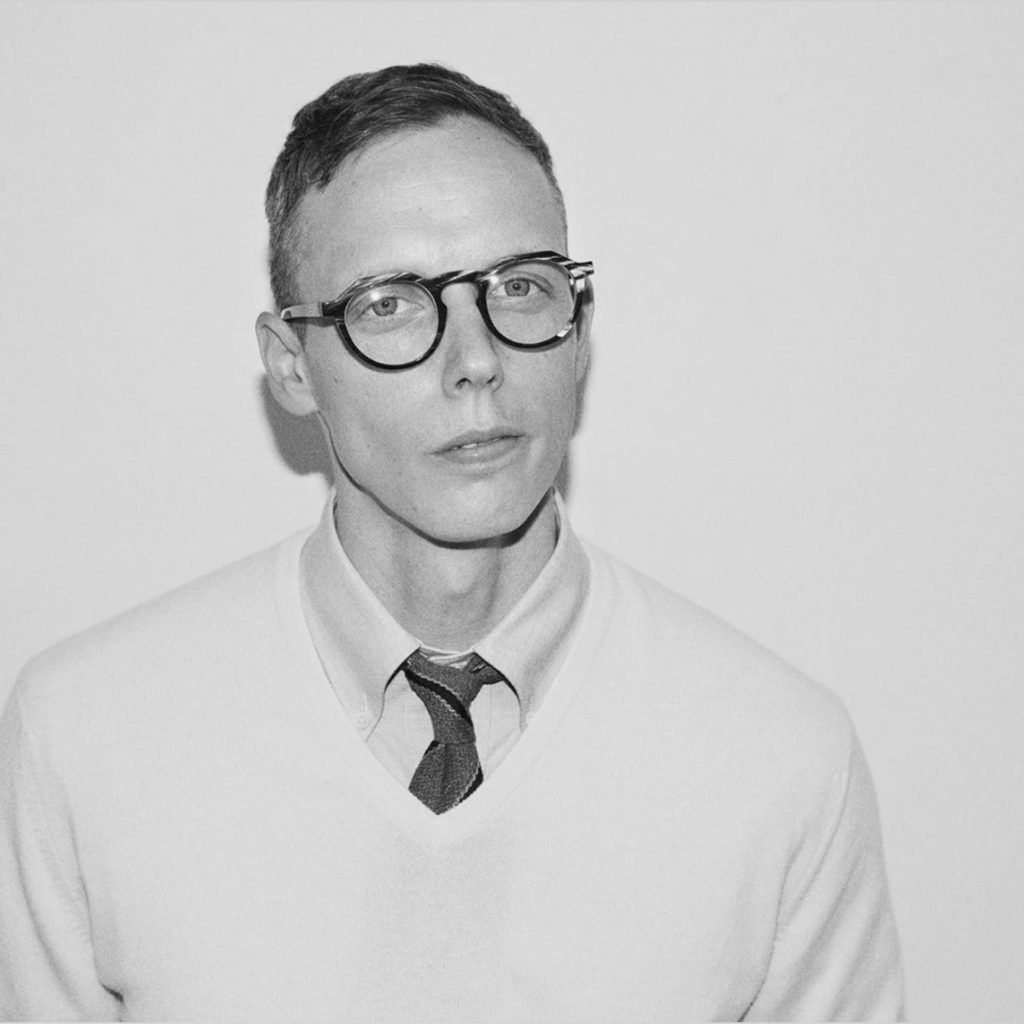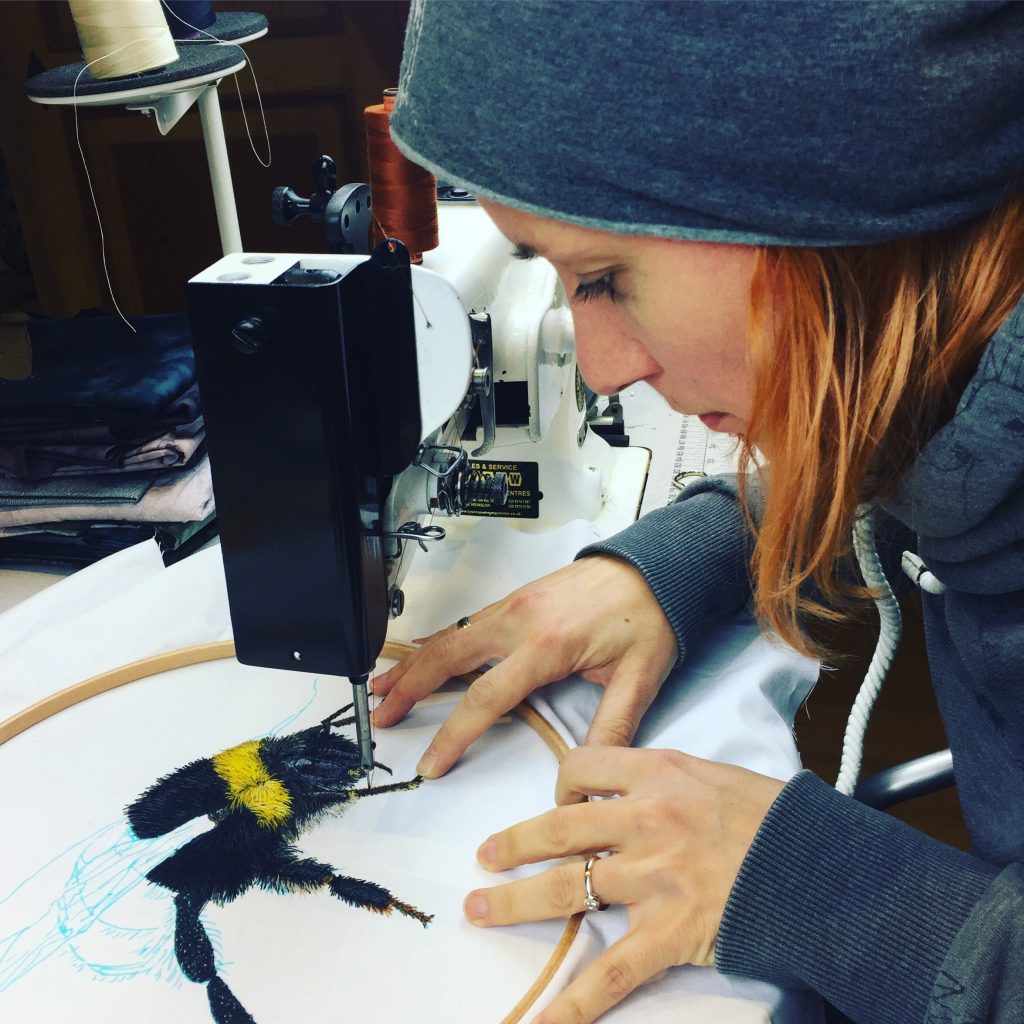Betsy Hershberg Knitter Of Fine Jewellery And Accessories - Pennsylvania, USA
You have been knitting since you were eight years old, and have studied with some of the world’s best known knitters. Can you tell about one or two techniques that they have passed on to you?
The inimitable Lily Chin is actually responsible for setting me on this path as she is the instructor who taught me the basic techniques of bead knitting. I will be forever grateful. The most important thing I have gathered from the wonderful instructors I’ve been privileged to know is not a technique however: it is to listen to and trust my own voice. Once you start creating work out of a desire to please others, your own voice can easily be lost.
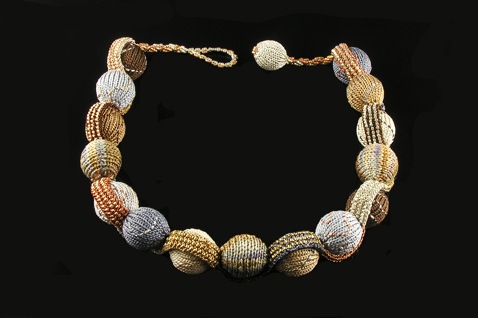
Meander 1
In 2002, now ten years ago, your knitting world was “turned upside-down.” Can you explain what happened?
I wish I knew HOW to explain it. I took a six hour class on basic bead knitting and from then on, all I’ve wanted to do was play with beads and fibre. After thinking of myself as an accomplished knitting technician for all of my knitting life, something about what seemed to be the endless possibilities for combining these two materials unlocked a creativity capacity for knitting that I had never imagined existed in me. I am intrigued by the contrast between hard (the beads) and soft (the fibre) and love the challenge of using them to create wearable, three dimensional forms from techniques that most often result in two-dimensional fabric.
You think of yourself as “left brained.” What do “you” mean by this?
Along the lines of how science defines people who are left-brained dominant (almost everyone has some characteristics of the opposite side of the brain), it’s a way of categorizing how I think and work. My sister describes me as “concrete, linear, sequential” and that pretty much sums it up. I describe myself as pathologically organized and often, to my dismay, pathologically symmetrical. But as I get older and I watch my work evolve, I am learning to accept and even appreciate my natural way of doing things. I also recognize that it’s unlikely I could change, even if I wanted to.
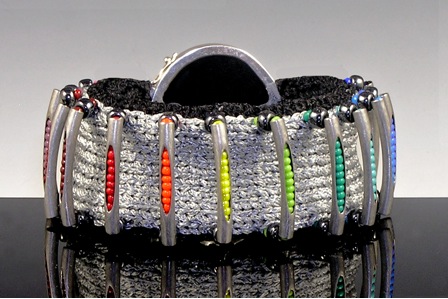
Barre Exercise
You get inspiration from many places. Can you elaborate on this?
I just think that all too often we rush through the world, taking notice only briefly of the things that catch our eye every day. If we would take just a few extra minutes now and then to not simply notice what things in our visual field we like or dislike, but try and ascertain WHAT IT IS we like or dislike about these things and then try to remember, even mentally catalogue them, we would be overwhelmed with more inspiration than we could act on in a lifetime. As a result of learning how to take time to notice things, I have an enormous number of visual images I use regularly when I work to translate the techniques I bring to my work into the components of bead knitted jewellery and accessories. I often say that my brain feels like an airport runway, with ideas just waiting in line to take off. It’s why I love making one-of-a-kind pieces. So many ideas to work on. Next!
Can you explain the importance of the word “Art” in your work?
My friends know of my lifelong struggle with what I call the “A” words. I just don’t understand the use of the word: who gets to decide what gets called art, who gets recognized as an artist and why. It all feels so loaded. It was in the process of writing my book that I came to terms with the fact that I can’t control what people think of my work – is it art? is it craft? – and in the end it doesn’t really matter. My obsession with “A” words had become an excuse for not trying new things – this worrying about what others would think. It’s been very liberating to let go of that struggle.
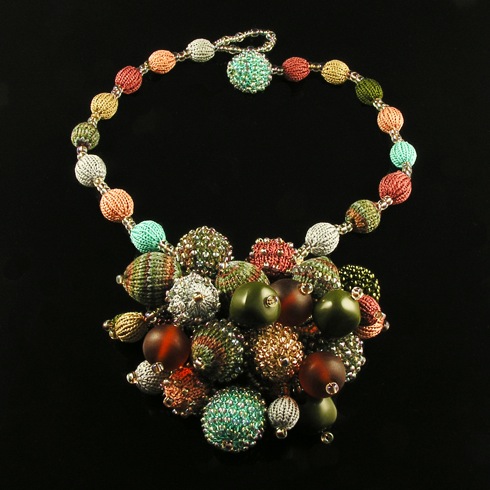
Andromeda
Your Work
Are all your pieces for sale, one-of-a-kind?
Most of my pieces are one-of-a-kind and I sell them only at juried craft shows or occasionally at trunk shows offered in conjunction with workshops or book signings. I know this makes it hard to acquire them, but I really feel like they need to be tried on before purchase. So while I do display them on my website, I have only rarely sold them after an inquiry from the site. I have a limited edition bracelet design and bead ball necklaces, both displayed on my website, that I do sell on request. I am hoping to add an e-commerce component to my website early next year (2013) where people will be able to order both finished work, new design patterns and materials kits.
Can you talk about your work?
Wavelength (2012): hand-dyed tassar silk, monofilament, Japanese glass beads, Chinese turquoise beads, sterling silver/foiledglassclasp
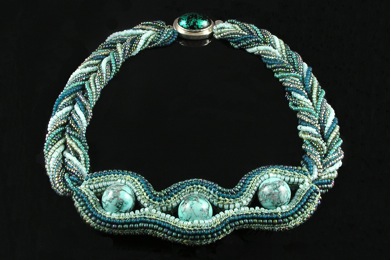
My favourite thing about this piece is how it is a mish-mash of so many different techniques and yet still works as a whole. If you only knew how many previous “reincarnations” it had before reaching this final version. I often change directions in the middle of working on a project, but this may be the only one so far that I had completely finished and assembled in different way and then disassembled and without too much additional work, re-engineered it into the format you see now. It’s also notable that there is no pre-strung bead knitting in this piece. Lots of weaving beads into knitted fabric and stringing many, many beads which are then manipulated into the shapes and patterns I wanted. It’s also interesting to note that although you can’t tell from a photograph, the three larger Chinese
Turquoise beads are each able to rotate within their space so you can view the lovely matrix of each in its entirety.
Morning Glory (2011): hand-dyed tubular rayon ribbon, perle cotton, monofilament, Japanese and Czech glass beads
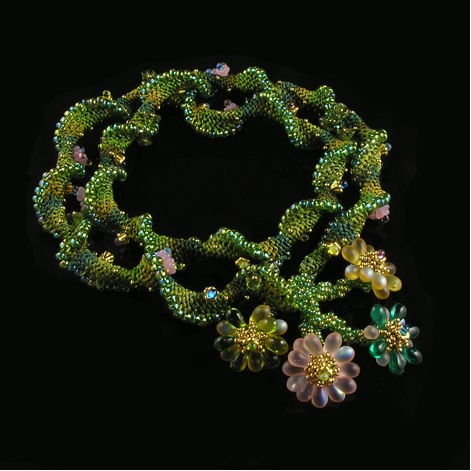
This piece resulted from one of my favourite “Ah hah!” design moments. I love the effect of using spirals in my work and had tried for years to figure out a way to make knitted I-Cord spiral without success. While working on projects for my book, I asked myself why knitters always work I-Cord using knit stitches. Why not use purl stitches? Could you even make I-Cord with purl stitches? So I cast on a few stitches and tried it. About 20 rounds in, the cord started to naturally spiral on its own and I had made my Eureka discovery. This lariat combines a bead knit spiral I-Cord, sewn bead embellishment, spiral bead weaving and four original off-loom bead-woven flowers.
Silver Orbits (2012): metallic cable thread, Japanese glass seed beads, wooden beads, sterling silver hoop earring findings; bead knitting.
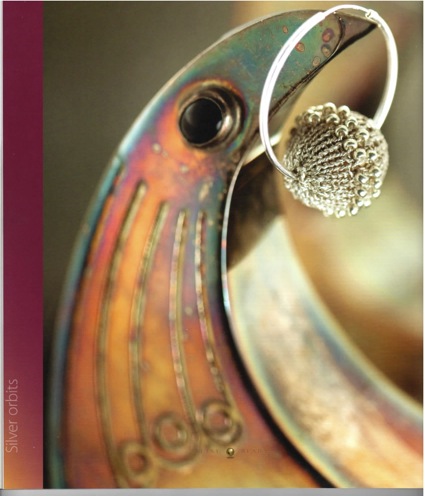
Photo: Alexis Xenakis, XRX Books, 2012
I think this little earring is a testament to the power of simplicity. So much of the work of making what I do is sourcing the materials that will work with the techniques, materials and tools I use. This extraordinarily strong yet flexible fibre, which is available only in silver and gold, is so much easier to knit with than wire and yet the finished fabric looks to me exactly like precious metal. And this incredible photograph, shot for my book by Alexis Xenakis, shows off every fine detail of the workmanship in a unique and evocative way. I love this photo and this piece.
Silver Ribs (2008): polyamide/viscose fibre, Japanese glass beads (triangles), sterling silver clasp
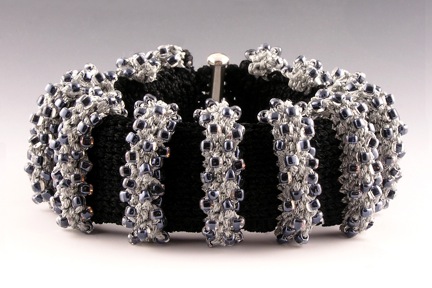
This bracelet was made several years ago and is a wonderful example of why I tell my students that for me, technique is at the root of all strong design. The way I began to experiment with bead knitting after I first learned the basic techniques was to take every knitting technique I knew and play with it by combining it with beads. So many possibilities for each technique! This bracelet is based on the knitting technique known as welting, which creates 3-D tubes on the face of a piece of knitted fabric. I decided to alternate colours, knit pre-strung beads onto the silver welts and this bracelet idea was born. Again, simple but strong.
Is your work very warm to wear? Does it work better in the cooler months of the year?
I rarely use what people would consider “warm” fibres – like wool or alpaca – for my work as to my eye they don’t suggest some of the inherent qualities of jewellery. I most often use silk, rayon and tencel, all of which work well with beads and often have a bit of sheen to them. I also knit with some very fine synthetic fibres more often used for embroidery or surface embellishment. What often surprises people is that with very few exceptions, my work is extraordinarily light weight. It is very easy and comfortable to wear.
Can you discuss the importance of new yarns that are coming onto the market and how they affect your work?
Despite the fact that I have several favourite, “go-to” fibres that I love to work with, I am ALWAYS on the lookout for new ones that will surprise me and inspire me to create something especially for their use. I am very fortunate these days that as a result of the success of the book, yarn manufacturers now often let me know about new fibres they think might work for me.
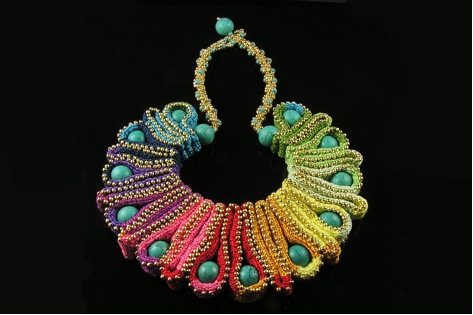
Meander II
Beads vary greatly, so how do you choose the beads you use?
I’m quite fond of the definition that says “anything with a hole in it can be considered a bead.” However, the range of beads that will work for my designs is considerably narrower. While I’m always excited to find unusual beads to use as focal pieces, I prefer to work with Japanese glass beads manufactured by Miyuki, Matsuno and Toho. The quality of these beads is unparalleled in the industry. And I am always thrilled when I can find good vintage Czech glass from the 20’s and 30’s.
You say, “I am proud to call myself a knitter.” Can you elaborate on this?
I am a knitter first, last and always. In some circles, knitting is still given short shrift, thought of as something that only grandmothers do and do badly. I hope that my work demonstrates a small part of what knitting CAN be.
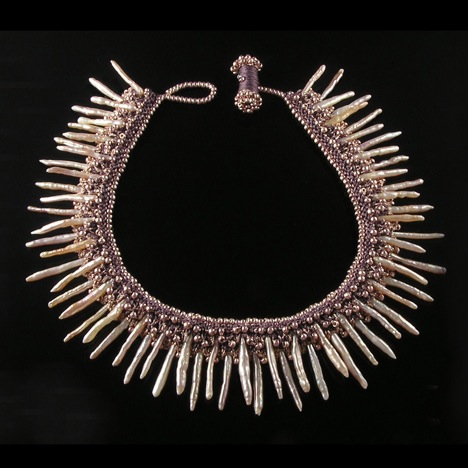
Pearlburst
In every piece I make, the knitted stitches are visible somewhere. I want people to be able to recognize that my work is knitted. Even though my design work grew out of my discovery of the possibilities inherent in adding beads to knitted fibre, as long as I have the proverbial two sticks and a string I’ll be happy.
Book and classes
You are now sharing your knowledge in your beautiful book, “Betsy Beads: Confessions of a Left-brained Knitter.” Can you explain how the book gained a life?
I had been approached by several publishers who had seen my work and wanted me to do pattern books and I really had no interest in that. Then XRX Inc, publishers of Knitter’s Magazine and beautiful craft books and the organizers of the popular Stitches Expos here in the United States asked if I had any interest in writing a book. They had published several of my patterns in the magazine and I had been teaching classes for them for several years. But it was only after another year of teaching, and realizing how many of my students shared my earlier struggles with thinking of myself as a creative knitter, that the idea for this book took hold. I wrote it to share what I have learned about a creative process for left-brained folks like me and then used my teaching and design experience to illustrate that process with technical instruction and lots of exciting patterns. This book would likely not have been written or published without the understanding of the team at XRX. They read my proposal and instantly got what I wanted to say and do and supported it.
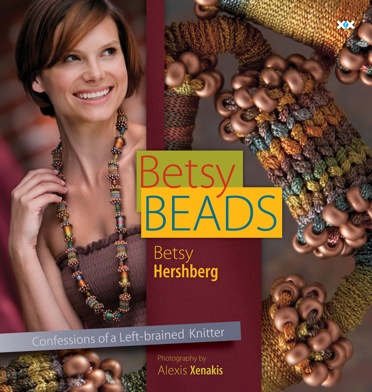
Can you also explain the need for excellent photographs for publication?
That’s simple. Especially given the amount of small detail in my work, without the eye of a gifted photographer, work like mine could not possibly come to life on the pages of a book.
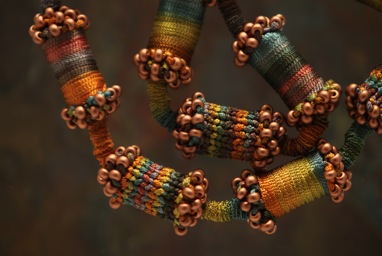
Alexis Xenakis, who was my photographer for the book (and who has helped me learn to improve the photographic skills I use to shoot my own work) is a genius in my opinion.
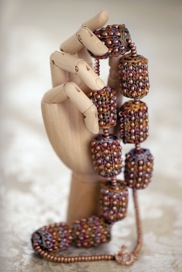
When I saw what he had done in capturing my work for the book, I sobbed in gratitude. I call him “The Illuminator”
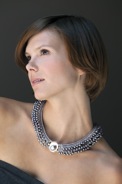
Photos by
Alexis Xenakis.
How can readers get their own copy of your book?
It’s available in yarn stores all over the US. I don’t know if it has reached Australia yet although I do know of several students I have “down under.” The easiest way to buy it is through Amazon.com or other online retailers I believe.
You also teach classes. Can you tell us about both classes “Brilliant Knit Beads” your online video class and classes you teach face to face?
The “Brilliant Knit Beads” class is 5 hours of online, streaming video available through Craftsy.com, a relatively new US company that has taken the craft world by storm. They offer classes in all kinds of crafts and once purchased the class is yours forever, to watch as many times as you’d like on your computer or tablet device. In addition, Craftsy instructors interact with our students as they are able to ask questions, post project pictures and create a wonderful new community. The class can be previewed at http://www.craftsy.com/class/brilliant-knit-beads/98
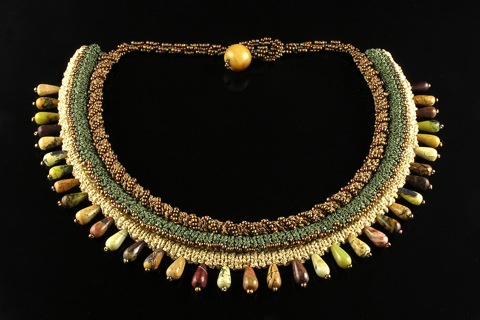
It is through my Craftsy course that I have “met” my students around the world, including some really talented ones in Australia! In addition, I teach live classes all around the US at large expos, yarn stores and guilds. Upcoming class information can be found on my website, on Ravelry.com and soon on my Craftsy instructor page. I also have a Ravelry Group (Betsy Beads Fans) where I interact with and try to help bead knitters from all over the world.
Visit Betsy Hershberg’s website: www.studiobknits.com
Betsy Hershberg, Pennsylvania, USA
Interview by Deborah Blakeley, December, 2012
Think a colleague or friend could benefit from this interview?
Knowledge is one of the biggest assets in any business. So why not forward this on to your friends and colleagues so they too can start taking advantage of the insightful information the artist has given?
Other artists you may be interested in:


